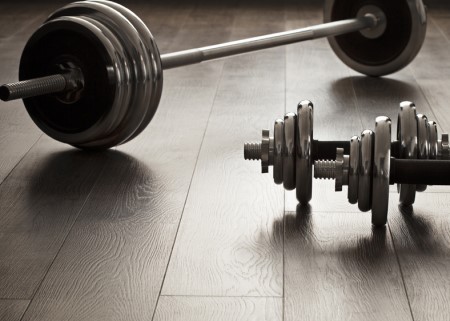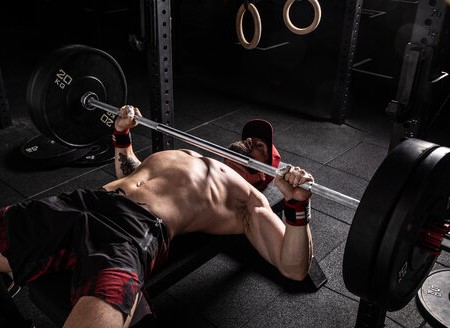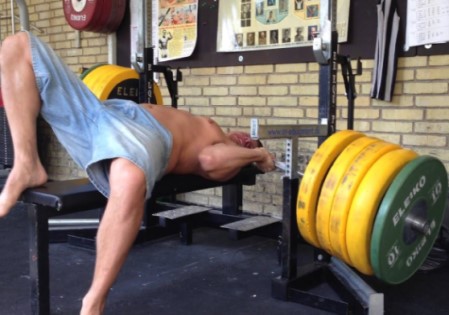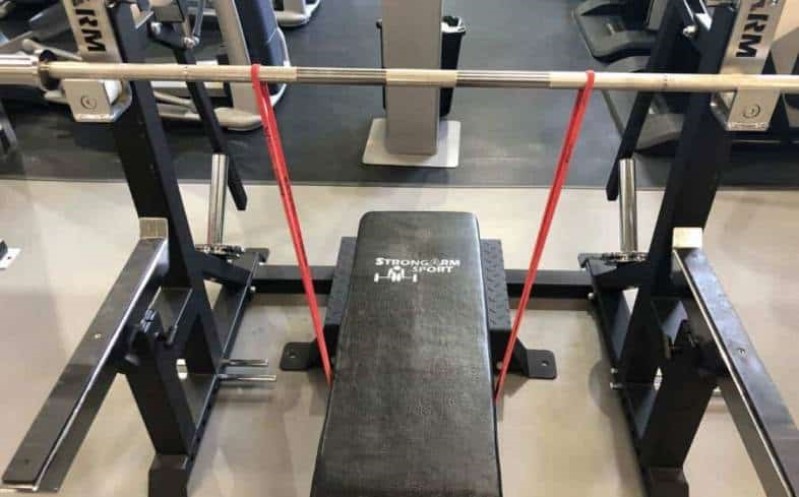Bench exercise being one of the most popular exercises for weightlifters, is aiming to strengthen and increase muscle mass of the upper torso and the arms.
Bench presses with weights (free weights, barbells, kettlebells) can help to change the body type dramatically and increase the body displacement, as long as they are performed correctly.
This article refers exclusively to this type of exercise and aims to study all benefits offered, the difficulties any person faces and smart and useful techniques for higher muscle gains.
More specifically, below we present briefly the topics discussed:
- How Bench Press is performed?
- Most important benefits of exercise
- Muscles Participating in this exercise
- Instruments required for performing Bench Press
- For which persons these exercises are ideal
- Any variations of basic exercise
- Useful Tips for Beginners and not only
Here are the topics in detail.
How Bench Press Works

First prerequisite is to have a bench and weights of your choice (and capabilities). The classic execution of bench press is performed with the bench in a horizontal position.
Lie down with your back on the bench and start lifting the weights selected.
Sounds simple, however, you need to pay close attention to the technique for obtaining maximum profits and avoiding injuries.
A very important point requiring attention is self-concentration during the exercise. You should be 100% in the exercise at that moment and not thinking of other things or focusing your attention elsewhere.
The control of weight lifting and the pressures you exert should be absolute. Your every move needs to be controlled and supported by proper inhalations and exhalations.
It is also important to control the muscles involved in the exercise executed and not allowing the weight with no control.
Finally, even the way you hold the weights (the free weights or the bar) is very important in the result.
Attention. Not proper technique in exercise application may lead to injuries, or even unbalanced muscle rebuilding.
Many people complain of shoulder injuries when applying pressure, trying to identify the reason. The wrong technique (a technique possibly shown by a non-specialist) may cause serious injuries, resulting in abstaining from training for long time.
Besides, the incorrect application of exercise can offer great muscle benefits to a specific muscle group, while another remains untrained and disproportionate.
Most important Benefits of Exercise
Bench Press is not accidentally one of the favorite exercises for muscle rebuilding, as offers great benefits (mainly to muscles and not only).
See below the most important of them:
No.1: Reconstruction of muscles
Muscle hypertrophy is the goal of every weightlifter. Bench exercise is one of the main training processes for rebuilding a large amount of lean muscle mass (mainly in the upper part).
Triceps, chest and back are the main muscle groups aiming for strengthening with bench press. The choice of repetitions and sets number, exercise workout rate, weight, resting time is to determine the final muscle gains.
No.2: Endurance improvement
Increasing the load and the number of repetitions gradually helps to build better endurance. A visible improvement in abilities possibly verified every week, is a fact pushing your persistence to continue the regular training.
No.3: Physical Fitness
Endurance is a hallmark of fitness, without being the only one. Systematic weight training on the bench strengthens the torso while enhances the physical strength, increasing the overall athletic performance and improving the exercise time.
No.4: Physical Strength
As mentioned, making perfect sense, the exercise helps to improve the physical strength changing the body radically, so improving its performance.
No.5: Ribbing
Regular weight training reveals the veins while the muscles become clearly visible. The body acquires ribbing and a clearer structure than before.
No.6: Fat Loss
Every intense physical workout leads to body fat loss, a fact very important in the case of weight loss, muscle rebuilding and ribbing.
Muscles participating in this exercise

Bench press trains the following muscle groups (always depending on the variation of exercise selected):
- Triceps
- Thoracic (chest)
- Arms
- Rhomboids
- Anterior deltoid (shoulders)
- Latissimus Dorsi
- Glutes
Instruments required for Bench Press
A bench (fixed or sloping) and the weights to be used (free or bar) are the basic instruments required.
For which persons this exercise is ideal
Surely, this is a “flexible” exercise. The fact that the weight to be used is adjusted according to personal measures and endurance makes this exercise suitable for almost everyone.
Stimulates the entire upper body part and increases muscle mass (mainly in the chest, arms, shoulders, and even the back), dramatically.
Therefore, it is one of the exercises causing high muscle hypertrophy (though targeted mainly at the upper torso) and this is one of the most important reasons many athletes prefer it for their training.
Especially powerlifters and weightlifters “love” this exercise for the many physical benefits offered.
However, this is not an exercise aiming at professional athletes only. It’s quite the opposite. Anyone may be engaged in Bench Press, if wishing to increase the physical strength of torso and muscular displacement.
Any variations of Basic Exercise
Many variations of the basic bench press exercise attributing to different difficulty and degree of physical intensity to training. The weights to be used and the selection of bench (whether straight or sloping), is a good first way to determine the exact muscle group targeted and the intensity to be exerted on it.
A number of variations may be applied with the help of the bench. Push ups, handstand, burpees, squats, jerks, dips are just some of the alternatives available.
The result of each of the above exercises is different and completely controllable, meaning that a beginner or an experienced athlete may apply each of the above exercises.
Here are some of the most popular bench press exercises.
No.1: Classic Bench Press
As mentioned earlier, this exercise is the most basic version of bench press, applied with the back touching the bench in a horizontal position. Grasp the bar by upright above chest height and keep your arms outstretched.
Then lower the weight slowly and steadily (without making sudden or nervous movements that could injure you) to the height of your chest.
The feet remain firmly on the ground.
No.2: Pressure with Legs Raised
You apply the classic bench press as before, this time with legs raised high.
Make sure your feet are at a right angle to waist, in the air and shins parallel to bench and feet folded.
Though seems simpler, has the difficulty of no stability, offered when in contact with the floor.
Nevertheless, this activates the entire body and “awakens” all body muscles to achieve better balance.
This exercise requires a lot of concentration to be able to gain control of all muscles and apply it properly.
No.3: Press on a Sloping Bench
In this case, the exercise changes depending on the bench inclination selected. Depending on the position of bench, the muscle group you work on during the exercise also differs as well.
Therefore, in exactly the same way you sit on the bench – after adjusting it – and with your feet firmly on the ground to the right and left of the bench you take the bar from the upright and start lifting.
The weight should always be straight above on chest height and the arms in the final position outstretched.
No 4: Biceps bends on bench with Pulley
By placing the bench in front of a double pulley machine, you can apply biceps bends.
You lower the pulleys considerably – and to a point that serves you – and lie down on the bench holding the handles in your hands.
Your torso should be facing away from the machine (and not the other way around).
You start the bends by pulling the pulleys towards your chest and then slowly returning to the starting position.
In fact, our experts testify that this biceps exercise is more effective (especially in terms of muscle gains) than the classic dumbbell flexion exercise.
The weight used on the pulleys can greatly alter the difficulty of the exercise.
No.5: Triceps extensions in Bench
You place the bench in a sitting position or just sit on the edge of the bench (with no back support). You take the dumbbells (exercise not performed with a barbell) and with a starting position above the head with the palms facing up, you start the pressures. Slowly bend your elbows so the weight goes down almost to the height of your shoulders. Performance of exercise is correct when triceps feel the pressure.
No.6: Press on reclining bench
Performed in a similar way to press on the sloping bench. In this case, however, the exercise focuses mainly on the lower chest muscles.
No.7: Press with Closed Handle
Just like the classic version of bench press, start the press taking care to keep your elbows very “closed” to torso. The legs should be firmly on the floor and the back parallel to the ground.
It is very important that the arms are slightly narrower than the shoulder opening and apply the pressure with absolute stability of the load (without oscillations and nervous movements). The elbows should be “locked” and the movements need to be gentle and steady.
No.8: French Triceps Press with bar on sloping bench
You adjust the bench to desired point and lie on your back. You take the bar in your hands from the upright and hold it above your head in a handle a little more closed than the shoulder opening.
The elbows bent inwards and the arms fully extended.
Therefore, start to lower the bar slowly with a somewhat circular motion until you bring it behind your head and the arms reach a position perpendicular to biceps.
Useful Tips not only for Beginners

- You should never lift, in any variation of exercise selected, your buttocks during the application. The buttocks should be stable on the bench and keep the load moving steadily and smoothly from the lowest to the highest point and vice versa.
- You should not shrug your shoulders in trying to manage the pressure. The shoulders should always be down and back.
- The gaze fixed at a point opposite and not towards the bar. Looking at the load carries the risk of losing your concentration, causing injuries.
- The wrists of your hands when holding the bar are bent, while the bar should be grasped with the whole palm.
- Do not let the bar oscillate. If the weight used is high, you better to reduce it. You need to keep the weight constant as travels from the lowest to the highest pressure point, and vice versa. Any instability can lead to loss of load control and injury.
- Keep your elbows closed (unless you are experienced, as open elbows are the object of the exercise). A beginner is very easy to suffer injuries if does not keep his elbows closed to body to stabilize the path of the bar.
- Check the load you can withstand and do not exceed your capabilities. You can “play” more safely by maintaining a satisfactory load and increasing the number of repetitions to increase the degree of difficulty of the exercise.
- Do not increase the load you lift abruptly. The increase better done gradually and after you first manage to “master” the previous weight.
- Keep your torso tight and in the position defined by the respective variant of the exercise.
- Never forget to warm up (Stretching) before each workout. This way you will prepare your muscles for the exercise and you will avoid serious injuries.
- Do not neglect to rest between sets. Muscle relaxation will help you enter more vigorously in the next set and apply the exercise more correctly. So keep about 5 minutes of rest between tests to find your strengths.
- Prior to any other exercise planned for your daily workout, you should place the bench. Lifting heavy loads requires a relaxed body and full strength. After bench lifting (Bench Press), you can continue the rest of your training plan normally.
- Explosion helps to rebuild muscle mass in a short time, but should remain under control.
The movement should not lose in stability and determination, and in no case deviate from its trajectory.
Therefore, if you do not feel confident forget the explosions and aim for a more controlled application of pressure.
- Make sure you always maintain the body properly aligned as defined by each variation of the exercise. This is important in order to exercise properly, avoid injuries and gain maximum muscle benefits.
- Work on your weaknesses so you can master them in the end.
This way you will increase your physical strength and you will have better control of the load you lift in each exercise.






